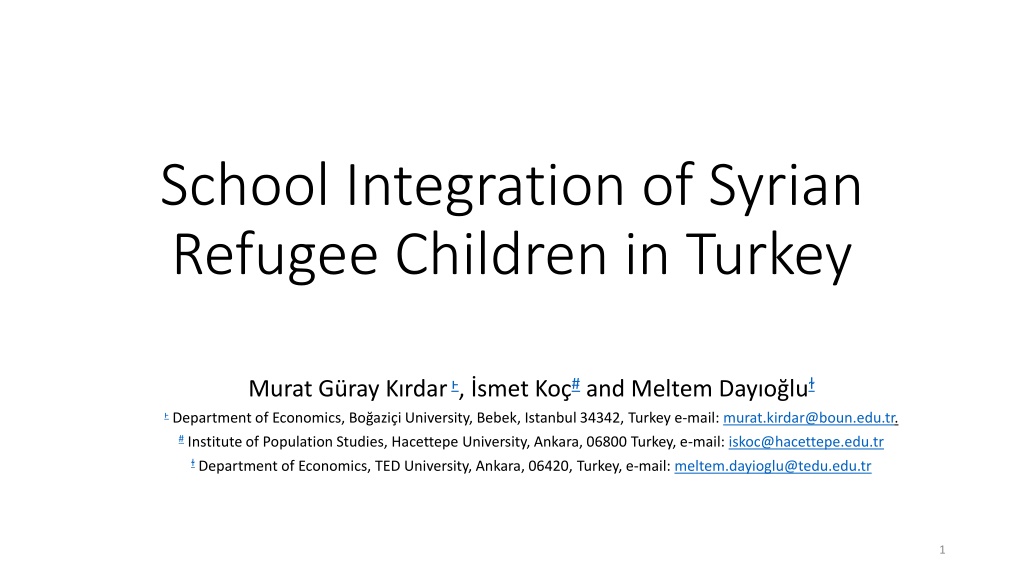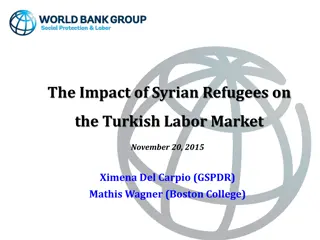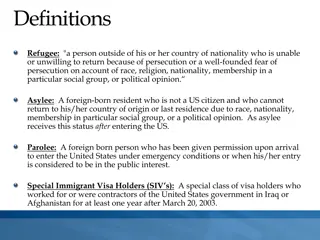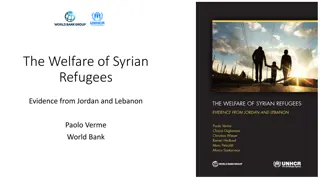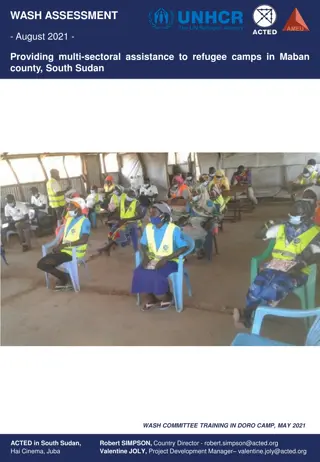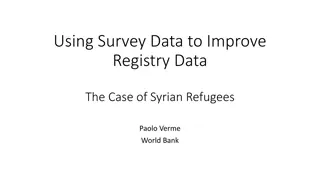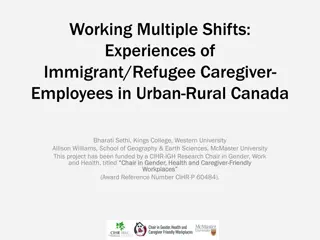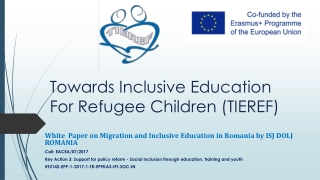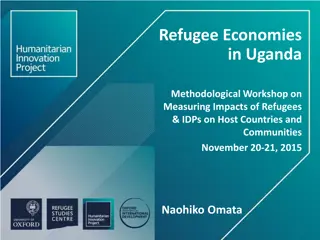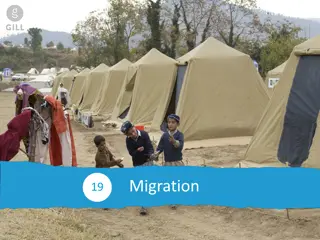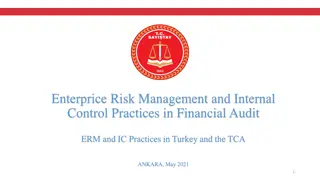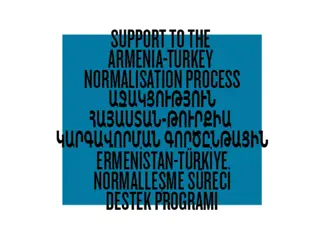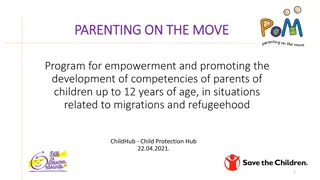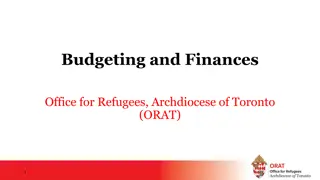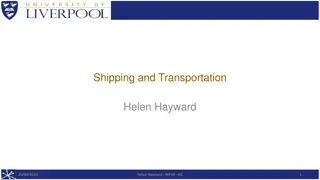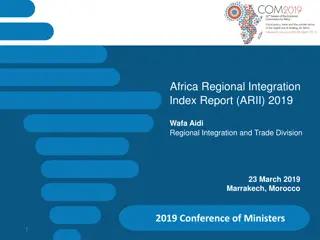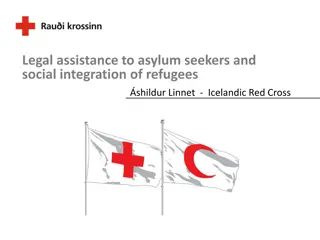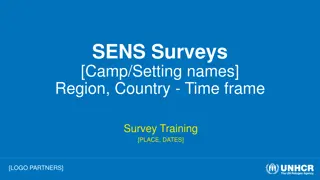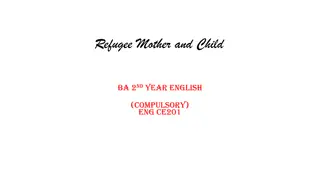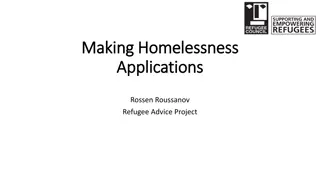School Integration of Syrian Refugee Children in Turkey: Key Findings
The study investigates schooling outcomes of native and refugee children in Turkey, highlighting disparities in enrollment, school performance, employment, and marriage. Analyzing data from the Turkey Demographic and Health Survey, the research reveals that socio-economic factors play a significant role in the educational achievements of refugee children. The findings emphasize the importance of age at arrival and address gender-specific patterns in school dropouts among refugees.
Download Presentation

Please find below an Image/Link to download the presentation.
The content on the website is provided AS IS for your information and personal use only. It may not be sold, licensed, or shared on other websites without obtaining consent from the author. Download presentation by click this link. If you encounter any issues during the download, it is possible that the publisher has removed the file from their server.
E N D
Presentation Transcript
School Integration of Syrian Refugee Children in Turkey Murat G ray K rdar , smet Ko #and Meltem Day o lu Department of Economics, Bo azi i University, Bebek, Istanbul 34342, Turkey e-mail: murat.kirdar@boun.edu.tr. #Institute of Population Studies, Hacettepe University, Ankara, 06800 Turkey, e-mail: iskoc@hacettepe.edu.tr Department of Economics, TED University, Ankara, 06420, Turkey, e-mail: meltem.dayioglu@tedu.edu.tr 1
What we do We document the differences in schooling outcomes of native and refugee children and seek to understand the underlying causes of these differences. We analyze several schooling outcomes, including enrollment status, ever attending school, grade for age, as well as school performance indicators, such as progressing, repeating, and dropping out conditional on enrollment. We also examine children s employment and marriage outcomes to better understand the observed patterns in schooling outcomes. 2
Data Turkey Demographic and Health Survey (TDHS). For the first time in 2018, the TDHS included a module (TDHS-S) to collect information on Syrian refugees in Turkey. Both the TDHS and TDHS-S collect rich information on sample households demographic and socioeconomic characteristics, including children s schooling. In addition, both the TDHS and TDHS-S are representative of their respective populations. Our main target group is school-aged children. Considering late school entry for both Turkish and Syrian children, we restrict the sample to 7 17-year-olds. 7,219 children in the Turkish sample and 3,010 children in the Syrian sample 3
Summary of Key Findings Accounting for a rich set of socioeconomic variables, we find that the native refugee gap in school enrollment drops by half for boys and two-thirds for girls, but the gap persists for both genders. When we restrict the sample to refugees who arrived in Turkey at or before age 8 and account for socioeconomic differences, the native refugee gap completely vanishes for both boys and girls, indicating that school integration of refugee children in Turkey has been possible conditional on their age at arrival. We also find that the timing of boys school dropouts coincides with their entry into the labor market, whereas girls dropouts mostly occur before marriage age. Finally, we document important differences between natives and refugees, as well as early and late arrivers among refugees, in never starting school, grade progression and repetition, dropping out, and grade for age. 4
Pre-war Period School Enrollment Rates of Syrian and Turkish Children by Age and Gender, SFHS-2009 and TDHS-2008 5
Initially, refugee children attended schools set up at the initiative of camp administrators. These camp schools were later turned into Temporary Education Centers (TECs) and established in off-camp areas as refugees gradually moved out of camps. Starting with the 2014 2015 school year, Syrian refugee children were accepted into Turkish public schools. The latest statistics from the Ministry of Education of Turkey (MoNE) indicate that over a third of school-aged Syrian children are not attending school (MoNE, 2021a). While 41% of Syrian children were enrolled in the 2014 2015 school year, and this rate increased to 64% in the 2020 2021 school year. The most significant improvement was at primary and middle school levels, where the enrollment rate reached nearly 80%; however, enrollment remained low at 39% at the high school level. 6
Number of Syrian Students in TECs, Public Schools and Out-of-School Children, and School Enrolment Rates 7
B) Fraction with Paid Job C) Fraction Ever Married 9
Estimation In the estimation of native refugee differences by gender, we pool the school-age children in our sample (7 17-year-olds) and use the following specification, 17 ? + ?? ??= ?0+ ?1???????+ ?2????+ ?3??????? ????+ ?? 6 ? ??? = ? + ?? ?=7 Heterogeneous Effects by Age: 17?? 6 ? ??? = ? + ?=7 17?? 6 ??????? ???? ? ??? = ? + ?? 17?? 6 ??????? ? ??? = ? + ?=7 17?? 6 ??? ??= ?0+ ?=7 ? ??? = ? + ?=7 ? + ??, 10
Dependent Variable: School Enrollment (1) (2) (3) (4) (5) Baseline + Household Wealth Controls Baseline + Other Household Controls Baseline + Region Controls All Baseline Controls A) Full Sample Syrian -0.290*** [0.023] 0.067*** [0.019] -0.280*** [0.025] 0.067*** [0.019] -0.156*** [0.025] 0.070*** [0.018] -0.242*** [0.024] 0.065*** [0.018] -0.141*** [0.027] 0.066*** [0.018] Syrian * Female Syrian + Syrian * Female -0.223*** [0.023] -0.213*** [0.025] -0.086*** [0.025] -0.178*** [0.023] -0.075*** [0.026] Mean Value for Refugees Observations R-squared 0.637 8,773 0.288 0.637 8,773 0.294 0.637 8,773 0.315 0.637 8,773 0.317 0.637 8,773 0.339 11
Dependent Variable: School Enrollment (1) (2) (3) (4) (5) Baseline + Household Wealth Controls Baseline + Other Household Controls Baseline + Region Controls All Baseline Controls B) Age at arrival <=8 for Syrians Syrian -0.138*** [0.024] 0.012 [0.020] -0.121*** [0.025] 0.011 [0.020] -0.018 [0.026] 0.017 [0.020] -0.099*** [0.024] 0.01 [0.020] -0.003 [0.027] 0.013 [0.019] Syrian * female Syrian + Syrian * Female -0.126*** [0.023] -0.110*** [0.025] -0.001 [0.026] -0.088*** [0.023] 0.010 [0.027] Mean Value for Refugees Observations R-squared 0.830 7,589 0.115 0.830 7,589 0.122 0.830 7,589 0.148 0.830 7,589 0.144 0.830 7,589 0.170 12
Understanding school enrollment gaps in the context of child labor and marriage 16
Dependent Variable: Paid Employment (1) (2) (3) (4) (5) Baseline + Household Wealth Controls Baseline + Other Household Controls Baseline + Region Controls All Baseline Controls A) Full Sample Syrian 0.248*** [0.028] -0.197*** [0.023] 0.243*** [0.030] -0.198*** [0.023] 0.196*** [0.031] -0.197*** [0.023] 0.232*** [0.029] -0.194*** [0.023] 0.176*** [0.033] -0.195*** [0.023] Syrian * Female Syrian + Syrian * Female 0.050** [0.024] 0.045* [0.026] -0.001 [0.028] 0.037 [0.025] -0.019 [0.030] Mean Value for Refugees Observations R-squared 0.203 4,653 0.175 0.203 4,653 0.187 0.203 4,653 0.181 0.203 4,653 0.197 0.203 4,653 0.213 B) Age at arrival <=8 for Syrians Syrian 0.080** [0.034] -0.038 [0.030] 0.070** [0.036] -0.038 [0.030] 0.028 [0.037] -0.040 [0.030] 0.070** [0.035] -0.036 [0.030] 0.015 [0.039] -0.037 [0.030] Syrian * female Syrian + Syrian * Female 0.042* [0.025] 0.032 [0.027] -0.013 [0.029] 0.033 [0.026] -0.022 [0.031] Mean Value for Refugees Observations R-squared 0.065 3,550 0.052 0.065 3,550 0.056 0.065 3,550 0.065 0.065 3,550 0.075 0.065 3,550 0.090 17
Dependent Variable: Ever Married (1) (2) (3) (4) (5) Baseline + Household Wealth Controls Baseline + Other Household Controls Baseline + Region Controls All Baseline Controls A) Full Sample Syrian 0.001 [0.003] 0.009 [0.005] 0.001 [0.003] 0.009 [0.005] -0.005 [0.004] 0.009 [0.005] 0.000 [0.003] 0.009 [0.005] -0.002 [0.005] 0.009 [0.005] Syrian * Female Syrian + Syrian * Female 0.009** [0.004] 0.010* [0.005] 0.004 [0.004] 0.009** [0.004] 0.006 [0.005] Mean Value for Refugees Observations R-squared 0.045 4,654 0.833 0.045 4,654 0.833 0.045 4,654 0.833 0.045 4,654 0.834 0.045 4,654 0.835 B) Age at arrival <=12 for Syrians Syrian 0.002 [0.002] 0.000 [0.004] 0.003 [0.003] 0.000 [0.004] -0.002 [0.003] 0.000 [0.004] 0.001 [0.002] 0.001 [0.004] -0.001 [0.004] 0.001 [0.004] Syrian * female Syrian + Syrian * Female 0.003 [0.003] 0.003 [0.004] -0.001 [0.004] 0.001 [0.003] 0.000 [0.005] Mean Value for Refugees Observations R-squared 0.024 4,387 0.833 0.024 4,387 0.834 0.024 4,387 0.834 0.024 4,387 0.835 0.024 4,387 0.836 18
B)Gap in Paid Employment by Age C)Gap in Ever Married Status by Age A)Gap in Enrollment by Age 19
Other schooling outcomes, including performance indicators 20
(1) (2) (3) (4) (5) Baseline + Household Wealth Controls Baseline + Other Household Controls Baseline + Region Controls All Baseline Controls A) Never Been to School (Age>=8) Syrian 0.097*** [0.014] 0.073*** [0.012] 0.097*** [0.016] 0.073*** [0.013] 0.049*** [0.014] 0.023* [0.012] 0.089*** [0.014] 0.068*** [0.012] 0.053*** [0.016] 0.031** [0.014] Syrian + Syrian * Female Observations R-squared 7,962 0.062 7,962 0.065 7,962 0.085 7,962 0.089 7,962 0.113 B) Advanced (conditional on enrollment) Syrian -0.085*** [0.022] -0.043** [0.021] -0.072*** [0.024] -0.030 [0.022] -0.061** [0.025] -0.019 [0.023] -0.071*** [0.023] -0.032 [0.021] -0.053** [0.026] -0.014 [0.024] Syrian + Syrian * Female Observations R-squared 6,964 0.054 6,964 0.057 6,964 0.058 6,964 0.063 6,964 0.067 21
C) Repeated (conditional on enrollment) Syrian 0.055*** [0.018] 0.032** [0.016] 0.050** [0.020] 0.027 [0.017] 0.062*** [0.021] 0.039** [0.019] 0.056*** [0.019] 0.034** [0.016] 0.061*** [0.022] 0.040** [0.020] Syrian + Syrian * Female Observations R-squared 6,964 0.019 6,964 0.023 6,964 0.019 6,964 0.023 6,964 0.028 D) Drop out (conditional on enrollment) Syrian 0.031** [0.014] 0.012** [0.013] 0.022 [0.015] 0.003 [0.014] 0.000 [0.016] -0.020 [0.015] 0.015 [0.014] 0.003 [0.013] -0.008 [0.016] -0.026* [0.015] Syrian + Syrian * Female Observations R-squared 6,964 0.072 6,964 0.074 6,964 0.08 6,964 0.085 6,964 0.091 E) Grade for Age (conditional on enrollment) Syrian -0.987*** [0.085] -1.045*** [0.079] -0.983*** [0.092] -1.044*** [0.087] -0.700*** [0.090] -0.744*** [0.087] -0.942*** [0.088] -0.999*** [0.082] -0.710*** [0.099] -0.756*** [0.096] Syrian + Syrian * Female Observations R-squared 7,136 0.909 7,136 0.91 7,136 0.911 7,136 0.911 7,136 0.913 22
Conclusion A significant fraction of native-refugee differences in school enrollment (about half for boys and two-thirds for girls) can be explained by differences in socioeconomic characteristics between Syrian and Turkish households. A key finding is that once we restrict the refugee sample to children who have arrived in Turkey at or before age 8 and account for the socioeconomic differences, the native refugee gap completely disappears both for boys and girls. We also find a strong association between the timing of school dropouts and the timing of labor market entry among refugee boys, suggesting that these decisions are driven by a similar set of underlying factors. 23
The native-refugee differences in school enrollment essentially stem from refugees higher propensity for never enrolling in school. When we control for the socioeconomic differences between refugees and natives, refugees are, on average, no more likely to drop out than natives once they are enrolled in school. In terms of school performance, conditional on enrollment, refugee boys fall behind native boys, although they are a more select group due to their lower enrollment rates. Policy Implications: Targeted program for children arriving at older ages Improving refugee households income and living conditions would help improve children s school outcomes 24
A)Ages: 7 to 11 B)Ages: 12 to 17 25
A)Year of Arrival: 2012 and 2013 B)Year of Arrival: 2013 and 2014 C)Year of Arrival: 2014 and 2015 D)Year of Arrival: 2015 and 2016 26
